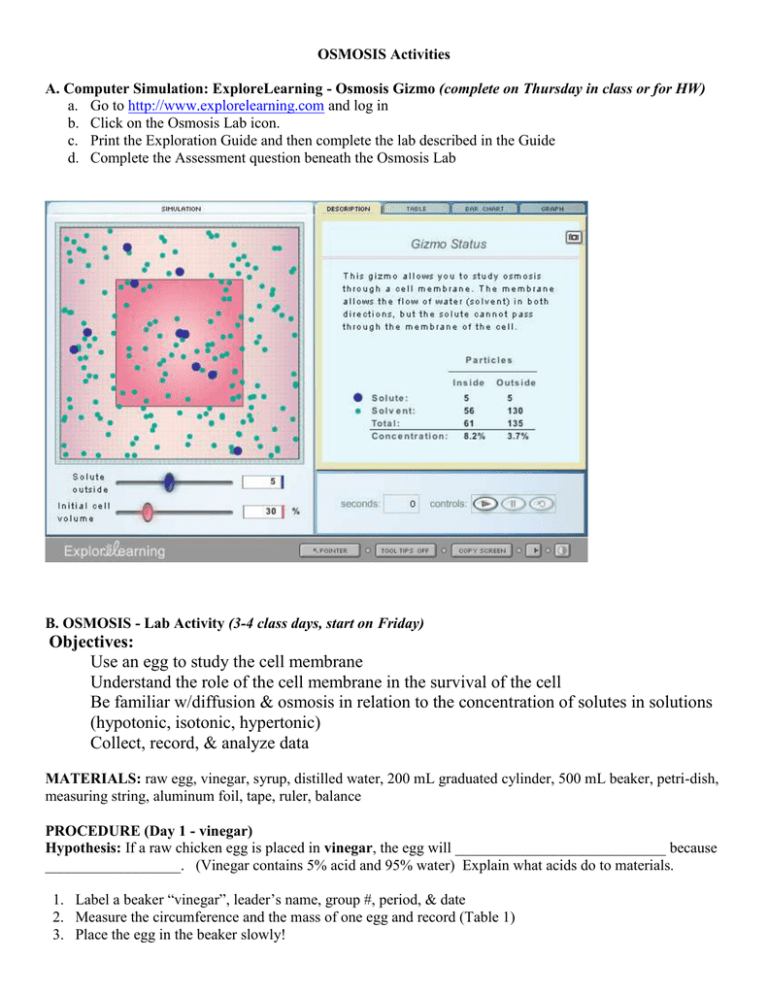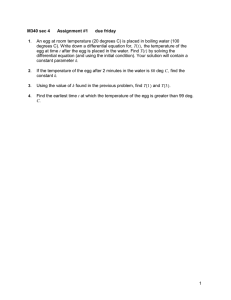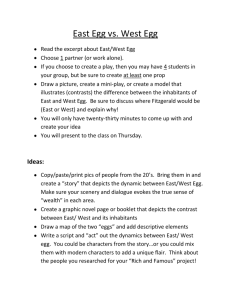B. Osmosis Egg Lab Activity
advertisement

OSMOSIS Activities A. Computer Simulation: ExploreLearning - Osmosis Gizmo (complete on Thursday in class or for HW) a. Go to http://www.explorelearning.com and log in b. Click on the Osmosis Lab icon. c. Print the Exploration Guide and then complete the lab described in the Guide d. Complete the Assessment question beneath the Osmosis Lab B. OSMOSIS - Lab Activity (3-4 class days, start on Friday) Objectives: Use an egg to study the cell membrane Understand the role of the cell membrane in the survival of the cell Be familiar w/diffusion & osmosis in relation to the concentration of solutes in solutions (hypotonic, isotonic, hypertonic) Collect, record, & analyze data MATERIALS: raw egg, vinegar, syrup, distilled water, 200 mL graduated cylinder, 500 mL beaker, petri-dish, measuring string, aluminum foil, tape, ruler, balance PROCEDURE (Day 1 - vinegar) Hypothesis: If a raw chicken egg is placed in vinegar, the egg will ____________________________ because __________________. (Vinegar contains 5% acid and 95% water) Explain what acids do to materials. 1. Label a beaker “vinegar”, leader’s name, group #, period, & date 2. Measure the circumference and the mass of one egg and record (Table 1) 3. Place the egg in the beaker slowly! 4. Add about 150 mL of vinegar to the egg in the beaker, so that the vinegar covers the egg. Note: the vinegar must cover the egg completely & if the egg has a crack, the experiment will not work. 5. Cover the beaker with aluminum foil and allow it to stand for at least 24 hrs. 6. Draw a picture of your experiment set up & write a description. (Table 2) PROCEDURE (Day 2 - syrup) 1. Observe what has happened to the egg. Draw the egg and write a description. (Table 2) 2. Remove and measure the vinegar in the beaker (Table 1) Do you have evidence to support your hypothesis from day 1? Explain 3. Very gently rinse the egg with water. Note: it is important to remove the white material (dissolved shell) from the egg. 4. Draw the egg and write a description. Note: have you ever noticed the thin skin that is present when you hard boil an egg and peel it? This “thin skin” is now the main focus of our experiment. 5. This thin skin will represent the cell membrane; explain what this skin has in common with a cell membrane. 6. Measure the circumference and the mass of the egg and record (Table 1) 7. Place the egg in a clean beaker 8. Measure 150 mL of syrup and pour it into the beaker with the egg. 9. Cover the beaker with aluminum foil and allow it to stand for 24 hrs. 10. Draw your experimental set-up and write your observations. (Table 2) Hypothesis: If this egg is placed in syrup, the egg will ___________________ because ___________ PROCEDURE (Day 3 - water) 1. Observe what has happened to the egg in syrup. Draw the egg and write a description. (Table 2) 2. Remove and measure the milk from the beaker with the egg 3. Rinse the egg with water 4. Draw and describe the egg. Note: give an explanation for your results (Table 2) 5. Measure the circumference and mass of the egg and record. (Table 1) Do you have evidence to support your hypothesis from day 3? Explain 6. Place the egg in a clean beaker 7. Add 150 mL of water and add it to the beaker. Hypothesis: If this egg is placed in water, the egg will ___________________ because ___________ PROCEDURE (Day 4 – final observation) Do you have evidence to support your hypothesis from day 4? Explain 1. Measure the amount of water that is left in the beaker. (Table 1) 2. Measure the circumference and the mass of the egg (Table 1) 3. Draw the egg and record observations. (Table 2) 4. Discard the egg in the container provided. DATA Table 1: Initial Vol. (mL) Final Vol. (mL) VINEGAR SYRUP DISTILLED WATER Table 2: Egg in Different solutions Initial Egg Circumference (cm) Final Egg Circumference (cm) Initial Egg Mass (g) Final Egg Mass (g) Beginning – Figures & descriptions End – Figures & descriptions VINEGAR SYRUP DISTILLED WATER ANALYSIS 1. Read the ingredients on the label of syrup container. Is the syrup high or low in water concentration? 2. How do you explain the volume of liquid remaining when the egg was removed from the syrup? 3. When the egg was placed in the water after being removed from the milk, in which direction did the water move? On what evidence do you base this? 4. Which solution was isotonic, hypertonic, hypotonic to the egg? Explain 5. What will happen if you were to break the “thin skin” of the egg? Apply this to a living cell and its cell membrane. 6. Why is a cell membrane needed in order for a cell to function? 7. Compare your hypotheses with your observations. Did you find evidence to support your hypotheses? 8. How did this experiment help you to understand how your cells in your body work to keep you alive? 9. Why do grocery store owners spray fresh fruits and vegetables with water? 10. If a shipwrecked crew drinks sea water, they will probably die. Why?






